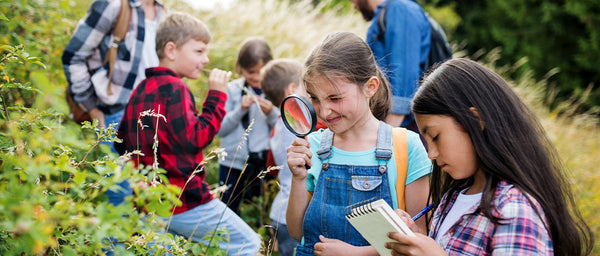
The Traditions of Summer: The Science Behind the Summer Solstice
For many, the Summer Solstice kicks off summer festivities, ushering in all the joys that come with the extended hours of much-needed sunshine. But those nearing the end of the school year are not the only ones anxiously awaiting the promise of more time in the sun.
Summer Solstice traditions are almost as ancient as the humans with whom they originated. Known as the First Day of Summer, Midsummer or St. John’s Day, the Summer Solstice is one of the most scientifically intriguing and culturally significant days in the calendar year!
Ancient Traditions:
Different groups celebrated the Summer Solstice with their unique traditions throughout history. Check out the significance of the longest day for these cultures around the world:
Egypt:
In Ancient Egypt, the solstice coincided with the rising of the Nile River. As predicting this annual flooding affected the civilization’s survival, the Egyptian New Year began with this important day.
Ireland:
In early Irish cultures, townspeople would cut hazel branches on the Solstice eve to be used during hunts for gold, water and precious jewels.
Scandinavian:
Across different Scandinavian cultures, Midsummer celebrations and festivals hold huge importance because of the Summer Solstice’s vast difference from its snowy counterpart (a Norwegian Winter Solstice is marked as the shortest day of the year, with limited sunlight all day long!)
Europe:
Ancient Northern and Central European pagans lit bonfires in the hopes of boosting the sun’s energy. They believed this would lead to a fruitful harvest during the coming fall.
Greece:
Some Ancient Greeks not only used the Summer Solstice as the start of their calendars, but it also began their month-long countdown to their highly anticipated Olympic games!
Freebie:
These cultures and others relied heavily upon the sun’s gifts throughout the year. From farming to keeping track of time, they needed to note the sun’s positioning and duration in the sky.
Your learners can explore this phenomenon with our free STEM activity, Outdoor Science Experiments: Keeping Time without Modern Technology! Perfect for any Summer Solstice celebration, these DIY sundials give learners a tangible way to explore just how useful the sun was and still is for many.
The Science

Photo by: The Bureau of Land Management
Indeed, the Summer Solstice has been a meaningful day throughout history, but the science behind why it happens was not always known. Though referred to as “the longest day of the year,” the day itself isn’t actually longer. It just seems that way because the Earth’s northern hemisphere is receiving the most hours of sunlight it will get for the entire year.
But, why?
While early humans thought the Summer Solstice was a mystical day marked by magic and rituals, today we know this special day is a byproduct of the Earth’s 23-degree axis tilt. Instead of spinning vertically, the Earth is tilted 23-degrees to its side, which means that the sunlight hitting our planet’s surface is not equal throughout the year — the amount of sunlight that reaches the Earth changes throughout the year as the planet orbits the Sun.

Photo by: Przemyslaw "Blueshade" Idzkiewicz
According to Manchester University's Associate Director at Jodrell Bank Observatory, Dr. Tim O'Brien, those living in the northern hemisphere experience the longest day when the North Pole is tilted most toward the sun. He adds, “On the Summer Solstice, the sun rises at its farthest point around the eastern horizon." Moreover, the sun’s positioning at noon is most notable, as it is “as high above the horizon as it will ever get, and it sets at its farthest point around the west, so daylight lasts longer than on any other day in the year" (Hastie 2013).
Summer Solstice Today:
There are still many solstice traditions continuing all over the world today. Some wear flowers in their hair, decorate their homes, or light bonfires with friends to commemorate the season. For most, more hours in the sun creates more time for fun and exploration.
Want to engage your learners in meaningful STEM programs that capture the excitement of summer? Take your learners on journeys across the globe with hands-on programs that bring summer vacation right to their fingertips.
BrickLAB Famous Architecture:

Explore the world’s most amazing structures with BrickLAB Famous Architecture's many build challenges.
Did you know that Stonehenge is a popular site during the Summer Solstice? The remarkable, prehistoric monument attracts thousands of visitors each Summer Solstice celebrating the longest day of the year (History.com 2018). During an exciting construction crash course in Architecture Bootcamp, learners explore the Post and Lintels Build that has helped keep the ruins standing tall to this day.

As their travels continue, your learners will recreate builds designed by ancient civilizations that had an impressive understanding of design well before modern physics was better understood. From various pyramids to the famous Parthenon, STEM builds using our signature Perfect Brick are a great way to keep learning fun and engaging all summer long.
Traveling Artist:

Capture the beauty of summer with art from around the world! One popular summertime activity passed down from generation to generation, particularly in Australia is the Boomerang. While their designs vary, many reflect artistic styles used by the first Australians in their cave painting. Learners will love folding and painting their own boomerangs perfect for some outdoor fun.
Art is often inspired by nature and natural phenomena. For example, the small country of Ghana located in West Africa is well-known for the bright patterns that style their clothing. The gorgeous patterns often represent the wearer in some way and mimic a wide variety of natural events such as the rising or setting of the sun. In Traveling Artist, learners design their own Ghanaian Kente Clothes. They, too, can be inspired by the beauty of the summer season and what it means to them.
BrickLAB STEAMventures:

Whether your summer travels take you great distances or just down the block for a refreshing summer treat, chances are you’ll use a form of transportation to get you to your destination. The Flight Collection explores everything from planes and helicopters to the wonders of hot air balloons and rockets. The Transportation Collection, on the other hand, focuses on bikes, cars, trains and boats, keeping vacations a little bit closer to home.
Best of all, either is ideal for wherever learning takes you this summer. Instruction and activities are flexible enough for in-person, blended, and remote implementation, making learning a breeze. Learners and their families will also have a blast completing additional extension activities at home using the build.edventures.com website. These collections can drive captivating exploration that lasts throughout the summer months.
Conclusion:
With the Summer Solstice upon us, it’s time to fill those extra hours of daylight with STEM programs that will allow your learners to truly shine! Get started today by exploring any of our featured products, and discover some new traditions you’ll be excited to share with learners each and every summer!
What’s your favorite Summer Solstice activity to share with learners?
Leave a comment below and tell us all about it!
References:
Hastie, P. (2013, June 20). The science of the summer solstice. Retrieved June 20, 2018, from http://www.bbc.co.uk/science/0/22956681
History.com, T. Editors of History.com. (2018, August 21). Summer Solstice. Retrieved May 25, 2022, from https://www.history.com/topics/natural-disasters-and-environment/history-of-summer-solstice
Originally published by Thayne Casper on June 12th, 2018. Updated by Jessica Ventre on June 7th, 2022.









